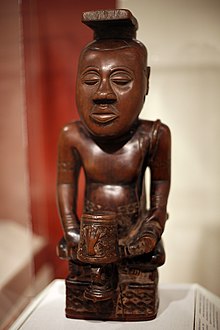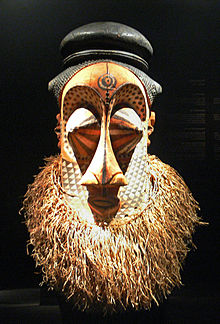Cuba Federation
The Kingdom of Cuba , more precisely the Cuba Federation , was an association of around 20 ethnic groups, all Bantu peoples, in Central Africa . Their largest ethnic groups were the Bushoong , the Ngeende , the Kete , the Shoowa and the Pyaang .
geography
The capital of the federation was Nsheng, in the center of its settlement area between the rivers Kasai , Sankuru and Lulua , in today's province of West Kasai in the south of the Democratic Republic of the Congo .
By the second half of the 19th century, while colonization was advancing in the west of the Congo area, the federation had an area of just over 100,000 km², comparable to the size of the GDR , and had around 150,000 inhabitants.
history
The Kingdom of Cuba was formed as a large empire on the southern edge of the equatorial forest area, where an extraordinary wealth of resources in the combination of forest, savannah and waters favored the development of dense and stable populations.
The age of the chiefs
The area was gradually settled by Mongo- speaking groups who advanced from the area between the Sankuru and Lokenye and mixed with the kete , who lived further south and belonged to the western Bantu language group. Several small communities emerged from the intermingling. They lived in autonomous village communities, often gerontocratic by a council of elders, occasionally also led by a sole head, whose sphere of control seldom exceeded a single village. After the end of immigration, around 1500, but possibly even earlier, one can speak of the Cuba in the real sense for the first time.
How far the history of this society goes back cannot be definitively determined due to a lack of sources, traditionally the Cuba date back to around the middle of the sixth century, their mythical founding father is Woot.
The age of kings
The Kingdom of Cuba developed in the first quarter of the 17th century when Shamba Bolongongo united the various chiefdoms. The territorial expansion was continued by his successors until around 1700.
There were regular disputes about heir to the throne among the princes. Nevertheless, the empire remained stable until the end of the 19th century. Based on a diverse environment and culture, the aristocracy of the dominant central ruling family of Shyaam also ruled distant regions and subordinate peoples and founded complex institutions such as an independent judiciary. The Cuba developed a lifestyle characterized by craftsmanship and sophistication, which was shown, among other things, in the skill of the weavers and wood carvers who made consumer goods for everyday life. Oratory, dispute, poetry and conversation have evolved into refined arts in the non-literate society.
Presumably a cultural diversity was preserved in the empire despite the unification. In the 18th century, three different creator deities were worshiped here: Mboom, who was worshiped by Mongo-speaking immigrants from the north, Ngaan, deity of the indigenous Kete, and Ncyeem apoong (Nzambi mpunga), who was perhaps from the Congo region by the founding king Shyaam Had been brought.
A peculiarity of the Bakuba is that here, in contrast to almost all other African societies south of the Sahara, the family model of polygyny disappeared between the 17th and 19th centuries and was only continued to be practiced by the chiefs. This led to an enormous drop in the bride price and a much younger age at marriage for men than in surrounding societies.
Due to its relatively inaccessible location in the south of what is now the Congo, away from the Congo River , Cuba was largely spared the slave hunts of the Europeans and Arabs in the 18th and 19th centuries. It could do without a military base.
The Belgians had tried to enter the Cuban Empire since the 1880s, but their gifts were always refused and King Kot aMbweeky aMileng threatened to behead any intruder. In 1892, however, the Afro-American Presbyterian missionary William Henry Sheppard was the first foreigner to invade the capital. Because of his black skin, he stayed alive and was able to live among the Cuba for 4 months. At that time, the Cuba Empire comprised approximately two thirds the size of Belgium and around 150,000 inhabitants.
Towards the end of the 19th century, the empire became unstable and finally fell apart under the subsequent Leopoldine and later Belgian colonial rule.
present
Today the Cuba are woodland planters and live in the southwest of the Democratic Republic of the Congo .
Arts and Culture


Her art, which was under the influence of the Congo Empire among other things, includes images of kings made of wood , called ndop . This court art can be dated back to 1600. Striking helmet masks , ceremonial objects, raffia fabrics and numerous ancestral figures are also included.
The Kuba used various weapons, including the war sword Ilwoon , the newer war sword Ngodip , the king sword Mbombaam , the short sword Ikul and its ceremonial variant Ikulimbaang . With the exception of the king's sword Mbombaam, the Kuba made copies of the weapons in wood. These wooden weapons were worn at certain times for ritual reasons. The status weapon Nshaal is also known .
List of rulers of the Cuba
| time | Official | Remarks |
|---|---|---|
| around 550 | handed down date of foundation | |
| Nyim / (Nyimi) (kings) | ||
| 1600 |
Shyaam Ambul Angoong (Shamba Bolongongo) |
Unification of Cuba |
| Bushoong Dynasty | ||
| 1776 to 1810 |
Kot Ambul , Nyim Kata Mbula |
|
| 1810 to 1840 |
Miko Mimbul , Nyim Mikope Mbula |
|
| 1840 to 1885 |
Mbop Amabiinc Mambul , Nyim Bope Mobinji |
|
| 1885 to 1890 |
Miko Amabiinc Mambul , Nyim Mikope Mobinji |
|
| 1890 to 1896 |
Kot aMbweeky aMileng , Nyim Koto Mboke |
|
| 1896 to 1900 |
Misha Aplyeeng , Nyim Mishanga Pelenge |
|
| 1900 to 1900 |
Miko Aplyeeng , Nyim Mikope Pelenge |
|
| 1900 to 1900 |
Mbop Pelyeeng II , Nyim Bope Pelenge |
|
| 1900 to ???? | Mingashanga beacon , Nyim | |
| 1900 to 1900 |
Kot Akyeen , Nyim Kwete Kena |
|
| 1900 to 1901 |
Mbop Akyeen , Nyim Bope Kena |
|
| 1901 to 1902 |
Miko Mikyeen , Nyim Mikope Kena |
|
| 1902 to 1916 |
Kot Ape , Nyim Kwete Peshanga Kena |
|
| 1916 to 1919 |
Mbop Ambiinc Mabweeky , Nyim Bope Mobinji Boke |
|
| 1919 to 1939 |
Kot Amabiinc Makyeen , Nyim Kwete Mobinji Kena |
|
| 1939 to September 1969 |
Mbop Amabiinc Makyeen , Nyim Bope Mobinji Kena |
|
| September 1969 to? |
Kot Ambweeky Ashyaang , Nyim Kwete Mboke |
|
See also
literature
- Jan Vansina : Geschiedenis van de Kuba van ongeveer 1500 tot 1904 (= 'Musée royal de l'Afrique centrale, Anthropology and Ethnography Annales Sér. In-8 ": Sciences humaines 44). Musée Royal de l'Afrique Centrale, Tervuren 1963.
- Jan Vansina: The Children of Woot. A History of the Cuba Peoples . University of Wisconsin Press, Madison WI et al. 1978, ISBN 0-299-07490-0 .
- John Iliffe : History of Africa ( Beck's Historical Library ). 2nd edition, Beck, Munich 2003, ISBN 3-406-46309-6 .
Web links
- Ada von der Betten: The Kingdom of Cuba - What Genetics Teaches About African History. (also as mp3 audio , 4.7 MB, 5:09 minutes) In: Deutschlandfunk broadcast “Research Current”. 11th February 2019 .
Individual evidence
- ^ Henri JM Claessen, Peter Skalnik (Ed.): The Early State , Walter de Gruyter , 1978, ISBN 9783110813326 , p. 376 [1]
- ↑ Rebecca Leuchak: Cuba (Zaire) , published by The Rosen Publishing Group, 1997 ISBN 9780823919963 , pp 46-48 [2]
- ↑ Christopher Spring : African Arms and Armor. British Museum Press, 1993, ISBN 0-7141-2508-3 , pp. 88-90
- ↑ Manfred A. Zirngibl , Alexander Kubetz: panga na visu. Handguns, forged cult objects and shields from Africa. HePeLo-Verlag, Riedlhütte 2009, ISBN 978-3-9811254-2-9 . Pp. 210-211, 312
